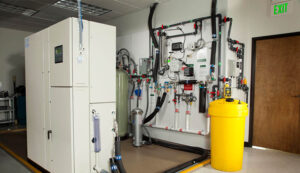What are the risks of poor-quality dialysis water?
Using poor-quality dialysis water can have significant risks and consequences for patients undergoing hemodialysis. Here are some specific risks associated with inadequate dialysis water quality:
Infections
Poorly treated or contaminated dialysis water can introduce bacteria, viruses, or other microorganisms into the patient’s bloodstream. This can lead to serious infections, such as bloodstream infections (septicemia), peritonitis (inflammation of the lining of the abdominal cavity), or access site infections. Infections can cause severe illness and, in some cases, may be life-threatening.
Endotoxin reactions
Endotoxins are harmful substances released by certain types of bacteria when they die. If present in dialysis water, these endotoxins can trigger adverse reactions in patients. Endotoxin exposure can lead to symptoms such as fever, chills, low blood pressure, nausea, vomiting, and even systemic inflammatory responses.
Chemical toxicity
Poor-quality dialysis water may contain high levels of chemicals or contaminants that can be toxic to the body. Exposure to these substances during hemodialysis can result in chemical toxicity, causing various adverse effects, depending on the specific chemicals involved. Symptoms may include nausea, vomiting, headaches, dizziness, shortness of breath, or even organ damage.
Adverse patient reactions
Dialysis water that contains excessive levels of minerals or metals, such as calcium, magnesium, aluminum, or copper, can cause imbalances in the patient’s electrolyte levels. This can lead to adverse reactions, affecting the heart, nervous system, or other vital organs. It is essential to maintain the appropriate balance of minerals in dialysis water to prevent these complications.
Damage to dialysis equipment
Poor-quality water can also harm the dialysis machine and its components. Contaminants or impurities in the water supply can clog or damage filters, membranes, or other sensitive parts of the dialysis equipment. This can lead to reduced treatment effectiveness, increased downtime for repairs, and additional costs for maintenance or replacement of damaged equipment.
Wrap up
To mitigate these risks, strict adherence to water quality standards and regular testing protocols are essential in dialysis centers. Healthcare professionals should closely monitor the quality of the dialysis water, implement appropriate treatment procedures, and ensure the maintenance of the water treatment system to provide safe and effective dialysis for patients.




